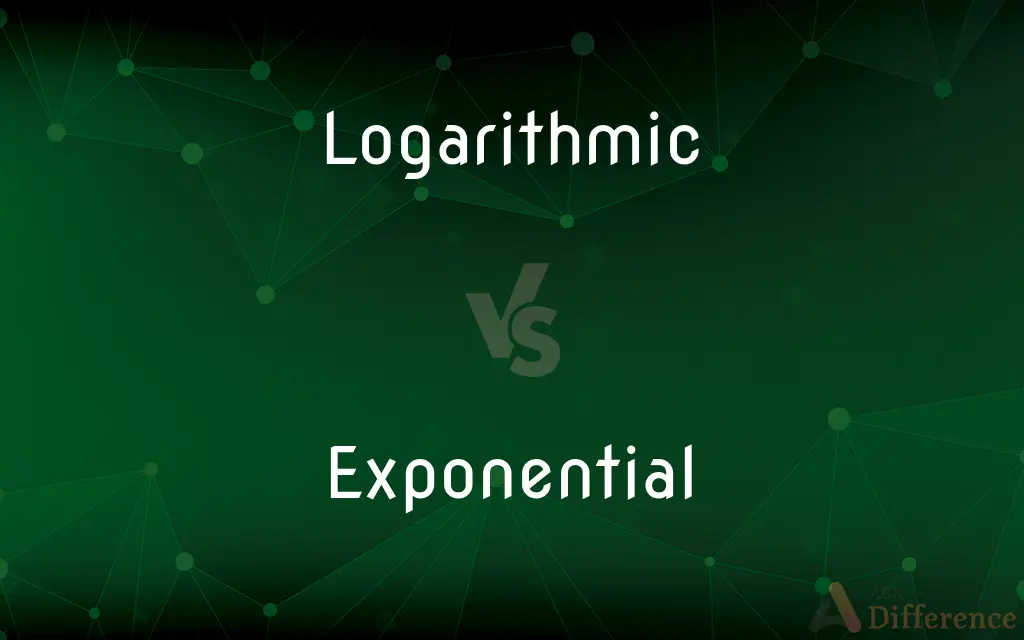Logarithmic vs. Exponential — What's the Difference?
By Tayyaba Rehman — Updated on October 12, 2023
Logarithmic pertains to the logarithm, which is the inverse of an exponential function, while Exponential refers to a rapid increase following a power law.

Difference Between Logarithmic and Exponential
Table of Contents
ADVERTISEMENT
Key Differences
Logarithmic functions are those that express quantities by logarithms, which are the inverse operations to exponentiation. They provide a way to inverse the process of exponentiation, translating multiplication into addition or powers into products. Exponential functions, on the contrary, involve growth or decay at rates proportional to the value of the function, resulting in rapid increases or decreases.
In practical applications, logarithmic scales are often used in scenarios where data spans several orders of magnitude, such as earthquake measurements or sound intensity. On these scales, equal distances represent equal ratios. Exponential growth, on the other hand, can describe populations, financial interest, or radioactive decay, where growth compounds rapidly.
When graphing, logarithmic functions result in curves that grow at a progressively slower rate. These curves flatten as they rise. Exponential functions, however, graph as curves that grow steeper with each unit increase, depicting rapid growth or decay.
From a foundational viewpoint, logarithmic functions reverse what exponentials do. For instance, if 2 raised to the power of 3 is 8, the logarithm base 2 of 8 is 3. Exponential functions, conversely, involve a base number raised to a power, such as 2^3, producing results like 8.
Lastly, in their nature, logarithmic functions describe scenarios where growth slows down as the value increases. Exponential functions capture scenarios where growth accelerates, leading to swift escalation or decline.
ADVERTISEMENT
Comparison Chart
Function
Inverse of exponential functions.
Power function depicting rapid increase or decrease.
Growth
Growth slows over time.
Growth compounds rapidly.
Typical Use
Measurement scales with wide-ranging data.
Population growth, compound interest, etc.
Graph Shape
Flattens as value increases.
Becomes steeper with each unit increase.
Mathematical Operation
Translates exponentiation into multiplication or addition.
Involves raising a base number to a power.
Compare with Definitions
Logarithmic
Expressing the inverse of exponential growth.
The logarithmic decline showed a slowing rate of decrease.
Exponential
Increasing rapidly following a consistent power law.
The spread of the virus showcased exponential growth in cases.
Logarithmic
Representing a number's power to which a base, like 10, must be raised to produce that number.
In a logarithmic function, one can determine the power needed to achieve a certain result.
Exponential
Involving a number raised to a specific power.
The equation represented an exponential function, with values skyrocketing.
Logarithmic
A scale that uses logarithms to depict quantities.
Decibels use a logarithmic scale to express sound intensity.
Exponential
Dramatic and swift escalation.
His popularity experienced an exponential rise after the performance.
Logarithmic
Pertaining to logarithms.
The Richter scale is logarithmic, measuring earthquake magnitudes.
Exponential
Pertaining to an exponent.
The bacteria's growth was exponential, doubling every hour.
Logarithmic
Progressing by powers of a consistent number.
The growth was logarithmic, with each step being a multiplication of the previous.
Exponential
Signifying growth at rates proportional to the function's value.
The investment saw exponential returns, compounding yearly.
Logarithmic
The power to which a base, such as 10, must be raised to produce a given number. If nx = a, the logarithm of a, with n as the base, is x; symbolically, logn a = x. For example, 103 = 1,000; therefore, log10 1,000 = 3. The kinds most often used are the common logarithm (base 10), the natural logarithm (base e), and the binary logarithm (base 2).
Exponential
Of or relating to an exponent.
Logarithmic
(mathematics) Of or relating to logarithms.
Exponential
Containing, involving, or expressed as an exponent.
Logarithmic
Of or pertaining to logarithms; consisting of logarithms.
Exponential
Expressed in terms of a designated power of e, the base of natural logarithms.
Logarithmic
Using logarithms; as, logarithmic graph paper; a logarithmic scale.
Exponential
Relating to an exponent.
Logarithmic
Having a logarithm in one or more of the unknowns; - of an equation.
Exponential
(mathematics) Expressed in terms of a power of e.
Logarithmic
Of or relating to or using logarithms;
Logarithmic function
Exponential
(mathematics) Characterised by a rate of change that is proportional to the value of the varying quantity, or, equivalently, by a doubling or halving over successive fixed intervals of time or other parameter.
Exponential growth, exponential decay
There were two deaths on Monday, four on Tuesday, and eight on Wednesday. The rate of increase seems exponential.
Exponential
(loosely) Characterised by a very rapid rate of change, especially increase.
Exponential
(mathematics) Any function that has an exponent as an independent variable. Category:en:Functions
Exponential
Pertaining to exponents; involving variable exponents; as, an exponential expression; exponential calculus; an exponential function.
Exponential
Changing over time in an exponential manner, i. e. increasing or decreasing by a fixed ratio for each unit of time; as, exponential growth; exponential decay.
Exponential
A function in which an independent variable appears as an exponent
Exponential
Of or involving exponents;
Exponential growth
Common Curiosities
What is Exponential growth?
Exponential growth describes a rapid increase where the growth rate is proportional to the current value.
Why are Logarithmic functions considered the inverse of Exponential functions?
Because logarithms reverse the process of exponentiation, translating multiplication into addition.
How is a Logarithmic scale useful?
Logarithmic scales can represent data spanning several orders of magnitude, making it easier to visualize.
Is compound interest an example of Exponential growth?
Yes, compound interest is an example where the growth compounds rapidly.
Why is Exponential growth alarming in contexts like epidemics?
Because it depicts swift escalation, leading to rapid spread.
What does Logarithmic mean?
Logarithmic relates to logarithms, which are inverse operations to exponentiation.
Do Logarithmic functions always depict slowing growth?
Typically, yes. They describe scenarios where growth rate diminishes as the value increases.
What's a real-world example of Exponential growth?
Population growth, when unchecked, can follow an exponential pattern.
Can Exponential be about decline?
Yes, exponential can describe rapid decline, known as exponential decay.
Can Exponential functions be used in finance?
Yes, especially in contexts like compound interest or investments seeing rapid growth.
Is the decibel scale Logarithmic?
Yes, decibels use a logarithmic scale to measure sound intensity.
How does a Logarithmic graph look?
Logarithmic functions result in curves that flatten as they rise.
What happens in Exponential decay?
Values decrease rapidly, at rates proportional to their current value.
Why is the Richter scale Logarithmic?
Because it deals with measurements that span multiple orders of magnitude, making a logarithmic scale more appropriate.
Share Your Discovery

Previous Comparison
Heterophone vs. Heteronym
Next Comparison
Exhortative vs. ExhortatoryAuthor Spotlight
Written by
Tayyaba RehmanTayyaba Rehman is a distinguished writer, currently serving as a primary contributor to askdifference.com. As a researcher in semantics and etymology, Tayyaba's passion for the complexity of languages and their distinctions has found a perfect home on the platform. Tayyaba delves into the intricacies of language, distinguishing between commonly confused words and phrases, thereby providing clarity for readers worldwide.














































